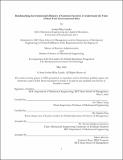| dc.contributor.advisor | Maria Yang and Charles Fine. | en_US |
| dc.contributor.author | Landis, Jordan Riley. | en_US |
| dc.contributor.other | Sloan School of Management. | en_US |
| dc.contributor.other | Massachusetts Institute of Technology. Department of Mechanical Engineering. | en_US |
| dc.contributor.other | Leaders for Global Operations Program. | en_US |
| dc.date.accessioned | 2020-09-03T15:52:08Z | |
| dc.date.available | 2020-09-03T15:52:08Z | |
| dc.date.copyright | 2020 | en_US |
| dc.date.issued | 2020 | en_US |
| dc.identifier.uri | https://hdl.handle.net/1721.1/126906 | |
| dc.description | Thesis: M.B.A., Massachusetts Institute of Technology, Sloan School of Management, in conjunction with the Leaders for Global Operations Program at MIT, May, 2020 | en_US |
| dc.description | Thesis: S.M., Massachusetts Institute of Technology, Department of Mechanical Engineering, in conjunction with the Leaders for Global Operations Program at MIT, May, 2020 | en_US |
| dc.description | Cataloged from the official PDF of thesis. | en_US |
| dc.description | Includes bibliographical references (pages 84-86). | en_US |
| dc.description.abstract | Li & Fung works with over 10,000 factories distributed across 50 countries to design, produce, and deliver hard- and soft- goods to over 2,000 apparel and consumer goods customers. An increasingly prevalent focus of the industry, driven both by regulation and consumer preferences, is to measure, benchmark, and reduce the overall environmental impact of the supply chain. Currently the measurement mechanisms in place rely on a traditional two-phase approach involving factory self-reporting and verification via independent audits. The scope of this project is to assess the efficacy of currently available measurement data in order to inform the requirements for real-time collected data. This project will be broken into four phases. First, existing industry data sources will be described and evaluated in order to assess data quality, understand requirements, and provide recommendations for future data collection. Second, the features of the data will be analyzed in order to develop an understanding of the underlining relationships. Third, using a set of selected features from the second phase, a predictive clustering algorithm for factory-level resource efficiency will be developed and used to benchmark factories. Finally, an analysis will be performed to evaluate the requirements of real time data and how real-time data could improve the benchmarking tool and future tools and services. | en_US |
| dc.description.statementofresponsibility | by Jordan Riley Landis. | en_US |
| dc.format.extent | 86 pages | en_US |
| dc.language.iso | eng | en_US |
| dc.publisher | Massachusetts Institute of Technology | en_US |
| dc.rights | MIT theses may be protected by copyright. Please reuse MIT thesis content according to the MIT Libraries Permissions Policy, which is available through the URL provided. | en_US |
| dc.rights.uri | http://dspace.mit.edu/handle/1721.1/7582 | en_US |
| dc.subject | Sloan School of Management. | en_US |
| dc.subject | Mechanical Engineering. | en_US |
| dc.subject | Leaders for Global Operations Program. | en_US |
| dc.title | Benchmarking environmental efficiency of garment factories to understand the value of real-time environmental data | en_US |
| dc.type | Thesis | en_US |
| dc.description.degree | M.B.A. | en_US |
| dc.description.degree | S.M. | en_US |
| dc.contributor.department | Sloan School of Management | en_US |
| dc.contributor.department | Massachusetts Institute of Technology. Department of Mechanical Engineering | en_US |
| dc.contributor.department | Leaders for Global Operations Program | en_US |
| dc.identifier.oclc | 1191623548 | en_US |
| dc.description.collection | M.B.A. Massachusetts Institute of Technology, Sloan School of Management | en_US |
| dc.description.collection | S.M. Massachusetts Institute of Technology, Department of Mechanical Engineering | en_US |
| dspace.imported | 2020-09-03T15:52:08Z | en_US |
| mit.thesis.degree | Master | en_US |
| mit.thesis.department | Sloan | en_US |
| mit.thesis.department | MechE | en_US |
